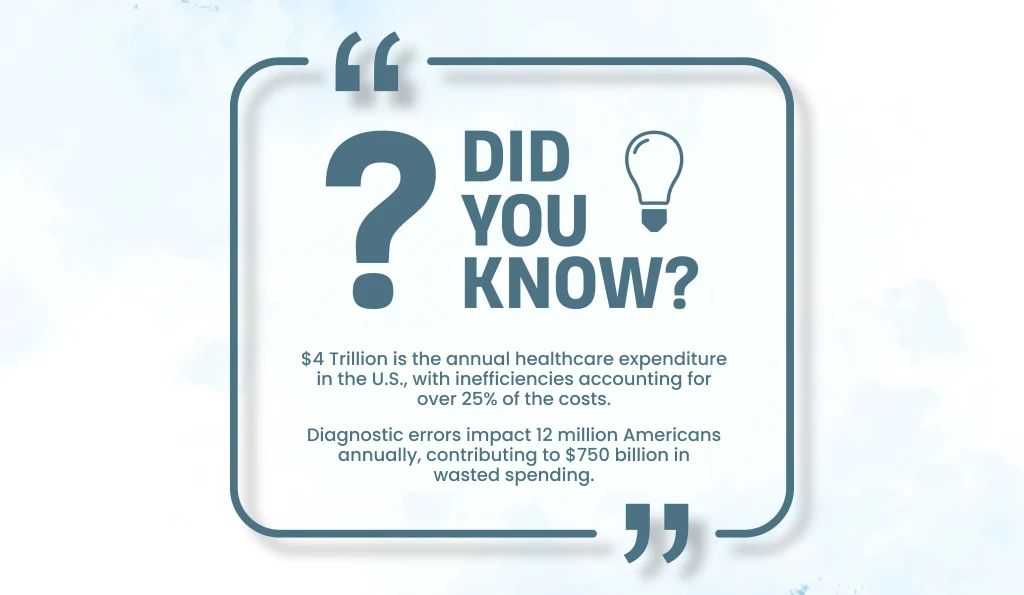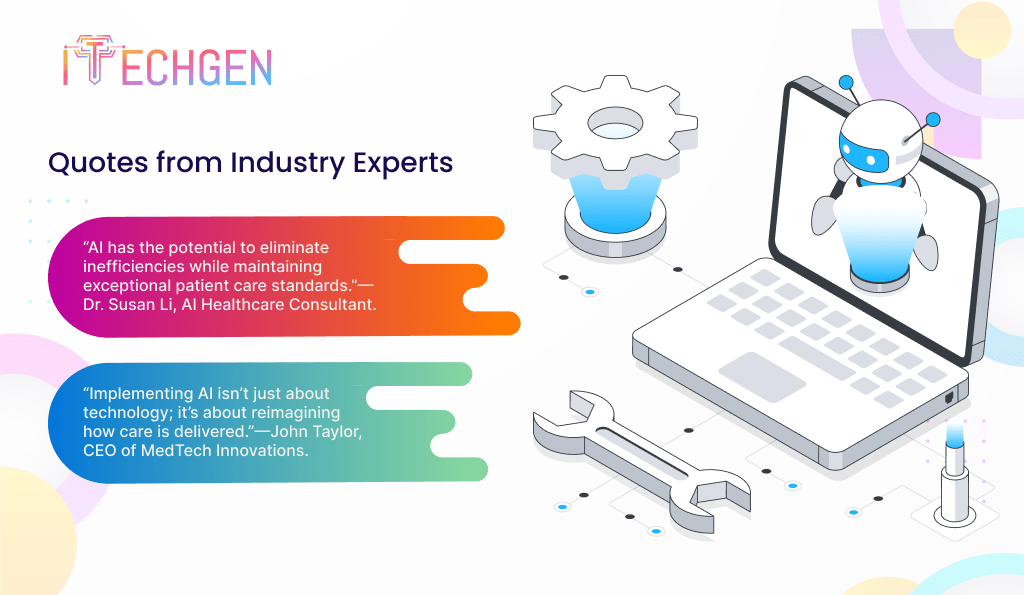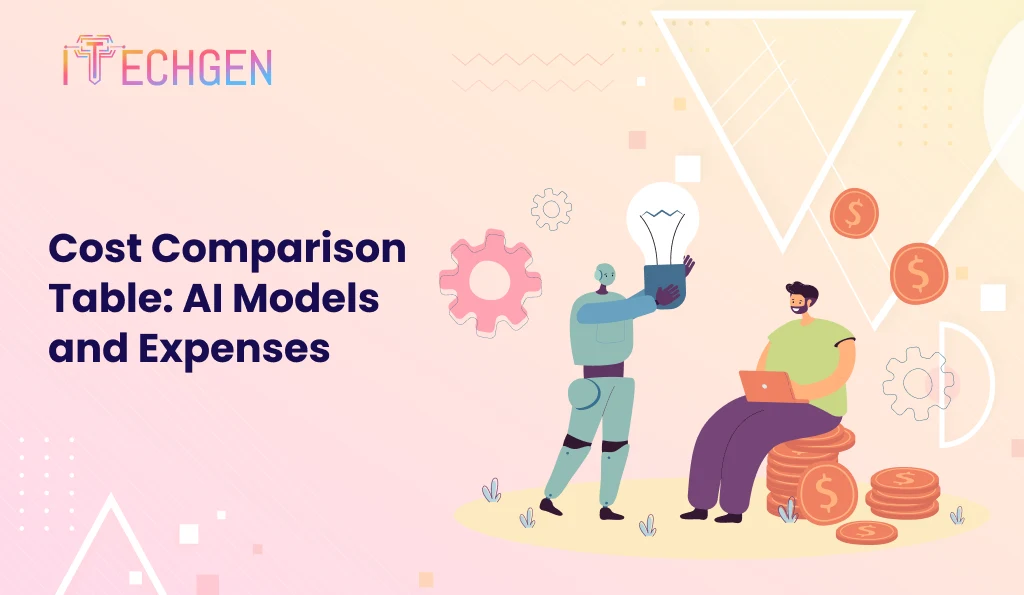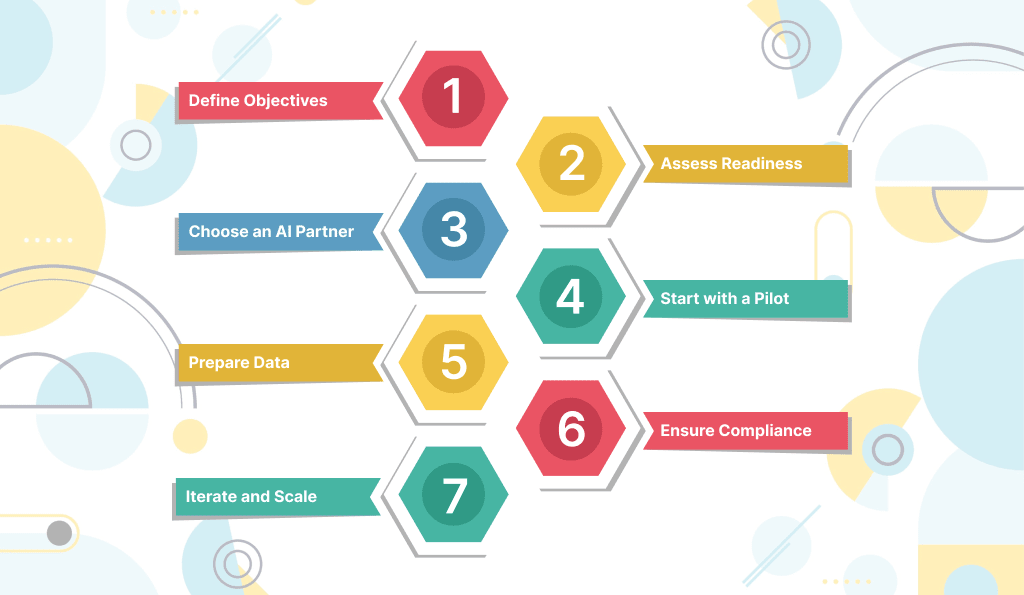
AI has begun to emerge as the most crucial transformative force in the field of healthcare, offering opportunities to achieve improved patient outcomes and more operational efficiencies, while only marginally increasing healthcare delivery costs.AI technologies will enable the streamlining of administrative processes, accuracy of diagnostics and much more than providing patients care or making healthcare decisions.
Though the cost involved in using AI in health care would not be the same for everyone, the overall amount that it would cost to install specific AI-solution mechanisms into health care organizations varies from organization to organization depending on several factors: the complexity and scope of the technology involved, the structure or size of the organization, and the specific health care use cases being targeted. While some AI applications, such as simple chatbots for patient communication, may come with relatively low costs; then, there are more sophisticated systems that would include machine-learning algorithms for images in medicine or even AI-augmented clinical decision support systems that would need heavy investments in infrastructure, expertise, and follow-up maintenance.
In this blog, we will examine The Cost of Implementing AI in Healthcare and the implications of a firm financial decision which any health organization should entertain when it adds AI. We will be taking up parts of the costs related to the overall adoption of such as complexity in solutions, data infrastructure needs, compliance, and integration- at the same time bringing cost-effective methods that such healthcare organizations would adapt to maximise their AI use. Understanding cost implications for AI in healthcare is vital for not just decision-makers and top finance officers but also for the successful delivery of AI initiatives that promise improved quality of care, operational efficiencies, and long-term financial sustainability.
At this time, the entire health sector is experiencing difficult times owing to high costs, inefficient service delivery systems, and demands for the provision of additional and improved health services. Today, again, with challenges being faced by healthcare systems across the globe, such pressure is placed on organizations to ensure that they are providing services efficiently, as well as timely and economically, against the incomplete resources available.
Cost increases are primarily driven by more chronic disease, ageing populations, and demands for more complex care. However as healthcare costs have skyrocketed, organizations have found themselves struggling to keep pace with the financial implications of providing safe, effective, and accessible care. The costs are additionally compounded by increased expenses associated with pharmaceuticals and medical equipment, as well as a dire need for constant development of infrastructure as these facilities mature and continue operations. As such, many healthcare institutions now find themselves faced with a large number of patients but constrained budgets that end up leading to resource shortages and workforce issues.
In such an environment of rising costs, endemic inefficiencies, and resource scarcity, healthcare organizations face an immediate imperative to look for innovative ways to cut costs, streamline work, and improve care for patients. By cutting repetitive activities, diagnostic accuracy, and resource optimization, Artificial Intelligence (AI) should be an answer to such problems.We will explore how AI can and will serve to be a game changer for healthcare and how it will transform the healthcare future in the upcoming sections.

AI has long been considered as just a future possibility. Now, however, it is a word used by healthcare for forecasting any change. Meanwhile, the functions of the providers will soon be changing with applications of AI that will enhance operational efficiency, clinical outcomes, and cost.
This is made possible since AI can process extensive portions of data with speed and accuracy, enabling healthcare organizations to optimize their workflows, improve the precision of diagnostics, and deliver large-scale personalized patient care.
With AI integration, both quality and efficiency can greatly improve healthcare delivery. AI technology is intended to help physicians in the decision-making process, automate administration, and make clinical processes a more effective atmosphere of healthcare operations. AI covers a wide range of interests in health care, such as diagnosis, monitoring, care planning, and various ways of minimizing human error, increasing efficiency, and enhancing the patient experience.
Also Read: ChatGPT vs Microsoft Copilot
AI is already making a significant impact across various healthcare applications, driving transformation. Key examples include:
While these applications are just a fraction of the potential that AI could bring to healthcare. As AI immerses itself in all aspects of care delivery, the impact of AI on enabling improved outcomes, decreasing costs and simplifying operations will only increase, and AI will be an essential piece of the healthcare puzzle for the future.
AI has a great deal of potential application in the field of health including the most accurate results, more operational efficiency, and the reduction of costs involved.


| AI Model | Use Cases | Development Complexity | Estimated Costs |
| Basic ML | Predictive analytics, administrative tasks | Low | $10,000–$50,000 |
| Deep Learning | Medical imaging, diagnostics | Medium | $100,000–$500,000 |
| Generative AI | Synthetic data, advanced simulations | High | $250,000+ |
Implementing AI in healthcare involves multiple financial considerations that vary based on the scope and complexity of the project. Below is a detailed breakdown of the key cost components and their implications:
A cloud-based AI is one of the cost-effective alternatives that come with limited upfront investment intended for smaller organizations. The AI can then scale the resources consumed by the organizations based on their usage demand. As the usage increases, ongoing cost factors start building up, such as subscription fees for data storage and processing. Then, there are privacy and security issues regarding some sensitive data from patients that include robust encryption measures and compliance.
In contrast, on-premise AI is more controlled and custom-built, as well as highly expensive, especially in the initial stages. It involves hardware, servers, and IT-managed infrastructure investments that can run from hundreds of thousands to millions of dollars, depending on the scale. Managing and maintaining such systems, then, involves specialized IT staff, creating a long-term operational cost burden.
Data preparation is a time-consuming and also expensive activity mandated for implementing Artificial Intelligence. It consists of collecting different pieces of information such as from electronic health records (EHRs), wearable devices, and medical imaging systems. Creating such disparate data may need investments in the most appropriate proprietary platforms or arrangements with outside sources, all bearing their cost, direct or indirect.
Once gathered, the data requires labelling, cleaning, and hence refinement to make it fit for training an AI model. Data labelling in healthcare is particularly expensive because prices depend on the complexity of the data from $0.05 to $0.50 per data point. Data cleaning-the identification and removal of inconsistencies, duplicates, and errors -itionally problematizes the expense. Excellent data preparation is essential for getting expected AI results, no matter how expensive.
AI adopts huge volumes of data, and adherence to healthcare acts such as HIPAA (in the U.S.) or GDPR (in the EU) does not budge for AI implementation. Organizations must invest massively in data protection measures which shall include encryption, regular audit schedules and securing patient consent in order to comply with such stringent standards. Most cases would need hiring compliance experts or legal advisors.
Artificial Intelligence will have additional certifications and approvals required for the demonstration of efficacy and safety in clinical practice. Federal and State regulators such as the FDA will require clinical trials and stringent testing that may cost up to hundreds of thousands of dollars. That’s because such processes ensure meeting the standards of the healthcare system. However, all of the above costs add to that of the implementation.
Among the many factors that determine success, the most important is that of the expertise of specialised professionals, data scientists, and AI engineers whose combined internal work most often focuses on the development, training, and maintenance of AI models. Salaries from $100,000 and up to $300,000 are reserved for such professionals, depending on their experience and the level of complication with the project tied to them.
Besides, the hiring of technical staff alone in some organizations may not be enough, they may have to involve clinical experts to ensure that the AI end product conforms to the best practices of medicine. Henceforth, technical and clinical teaming has to do with creating a very effective clinically relevant AI thus piling more personnel costs.
To operate effectively and securely, AI systems need constant monitoring, updating, and debugging. Such recurring operational costs often reach around 20% to 30% of initial investment on an annual basis. Regular updates are also necessary to meet the shifting demands of the health sector and legal requirements.
Software upgrades do not suffice if kept alone; performance monitoring would detect and resolve issues as soon as they happen. Maintenance and support should be of good quality to enhance AI operation for a long time without much disruption to the health business.
Read More: How to Tell if an Image is AI Generated?
AI-Powered Telemedicine Solutions
Example: An AI-based chatbot was developed by a healthcare startup to address certain patient interactions, about appointment arrangements, symptom checking, or a basic diagnosis. Such an innovative system could cut operational costs by up to 30% and by reducing time in patient response, health practitioners ultimately find more time to attend to important matters. The patient experiences clearly indicated examples of improved operational efficiency, as it reduced waiting times and, in effect, reduced the burden on these resources by automating some of the administrative work.
AI-Driven Cancer Prognosis Platforms
Example: AI was integrated into cancer diagnostic processes in a hospital that uses deep learning algorithms’ testing on medical imaging data to detect early signs of various cancers. The system had a diagnostic accuracy rate of 92% and shaved 40% off of time delays in cancer detection determination. This reduced the reliance of the initial screening on the radiologists, permitting them to shift their attention to more complicated cases while permitting earlier treatment with better patient outcomes.
ML-Powered Eye Lens Power Calculation
Example: Machine learning algorithms were used in an optical clinic to automate lens power calculation in patients undergoing cataract surgery. The AI system successfully predicted lens prescriptions, reducing the incidence of human error and increasing the accuracy of the procedure. Through faster, more reliable outcomes that also avoid costly corrections and help improve operational efficiency and patient satisfaction, this innovation saved the clinic over $2 million per year.

Budget Overruns and Timeline Delays
Unexpected costs (or lack thereof) and delays round out the list of common pitfalls with AI projects. You need to set realistic expectations; we need to define a detailed project scope; we need contingency budgets worthy of the risk. Periodic progress reviews and a flexible scope of time to account for all the unexpected happening on the way.
Data Scarcity and Privacy Concerns
A common obstacle is access to high-quality, labelled data. To avoid data scarcity, organizations can produce synthetic data or pursue third-party data providers to supplement their data. Furthermore, AI solutions have to be designed in a way that privacy concerns are taken care of; regulations like GDPR and HIPAA need to be adhered to, to allow the handling of such data securely and confidentially.
Integration with Legacy Systems
Many healthcare providers rely on legacy systems that do not easily work with modern AI solutions. However, to overcome this it is absolutely imperative to work with vendors who are experts in system integration. However, with these vendors, there can be the confidence that AI technologies can work with the legacy infrastructure, without disrupting operations and maximizing the value of both systems.
Recap of Benefits
The scope for AI application in the healthcare industry is vast and unmatched in the ability to change patient outcomes, cut costs, and increase work efficiency tremendously. AI can also lead to a much better diagnosis for better resource allocation in healthcare. Although investments run quite high initially, ROI would on the other hand yield a lot in the long run, not just in dollars saved but also in terms of the quality of personalized care. AI broadly ensures decreased errors, automates repetitive tasks, and implements decision-making to deliver healthcare more efficiently and effectively.
Final Advice
For healthcare organizations that are studying AI adoption, a phased approach makes sense. Before diving into crazy wacky scaley things, do some PoC projects so you can experiment and prove AI works in real life. This allows organizations to 1) assess feasibility before investing in scale AI solutions throughout the organization, 2) understand the ROI from their AI investments and 3) identify potential challenges associated with any AI solutions they implement. Testing AI apps on a smaller scale at first allows healthcare providers to refine their strategy and transition for a smoother, more successful rollout as it expands AI into other departments and functions.
Basic solutions can cost around $10,000, while the more advanced, complex and custom systems can transcend $500,000.
Among other barriers are the high upfront costs, scarcity of data, difficulty it poses regarding compliance, and difficulty of integration with legacy systems.
AI solutions can be tailored to specific organizational needs through pre-trained models, open-source frameworks, and vendor collaborations.

Pankaj Arora is the Founder & CEO of iTechGen, a visionary leader with a deep passion for AI and technology. With extensive industry experience, he shares expert insights through his blogs, helping businesses harness the power of AI to drive innovation and success. Committed to delivering customer-first solutions, Pankaj emphasizes quality and real-world impact in all his endeavors. When not leading iTechGen, he explores emerging technologies and inspires others with his thought leadership. Follow his blogs for actionable strategies to accelerate your digital transformation and business growth.
View More About Pankaj Arora